Dalat Before 1975
Hình ảnh: Dalat trước năm 1975.

TÌM LẠI DẤU XƯA: Đà Lạt ngày tháng cũ.
DA LAT
Đà Lạt , located in the central highlands at about 1475 m, has many names. „Little Paris“, „Le Petit Paris“, „City of Eternal Spring“. The cool climate and the park-like surroundings distinguish them from other city in Vietnam. Characteristic of this city. The climate is very pleasant, maximum temperatures are about 24 degrees and lows in the 15 degrees. The eternal spring …
The French endowed the city with villas and boulevards, and its Swiss charms remain today. Hébrard included the requisite health complex, golf course, parks, schools, and homes but no industry. The legacy of boarding schools where children from the whole of Indochina were taught by French priests, nuns, and expatriates still existed as late as 1969. In 1929, the Christian and Missionary Alliance established a school (Dalat International School) for Canadian and American children of missionaries serving in Southeast Asia. In 1965, the school moved to Bangkok, Thailand; then in 1966 to the Cameron Highlands in Malaysia and then, in June 1971, moved to its present location in Georgetown, Malaysia. There were seminaries of Jesuits (such as Pius X Pontifical College) and other orders.
During the 1890s, explorers in the area (including the noted bacteriologist Alexandre Yersin, protégé of the renowned French chemist Louis Pasteur), which was then part of the French territory of Cochinchina, asked the French governor-general, Paul Doumer, to create a resort center in the highlands. The governor agreed. The original intended site for the hill station was Dankia, but Étienne Tardif, a member of the road-building expedition of 1898-99, proposed the current site instead. In 1907, the first hotel was built. Urban planning was carried out by Ernest Hébrard.
-Đà Lạt, située dans les hauts plateaux du centre à environ 1475 m, a beaucoup de noms. „Petit Paris“, „Le Petit Paris“, „ville de l’éternel printemps“. Le climat frais et les environs du parc comme les distinguer des autres ville du Vietnam. Caractéristique de cette ville. Le climat est très agréable, les températures maximales sont d’environ 24 degrés et des bas dans les 15 degrés. Le printemps éternel …Ville de montagne romantique, Đà Lạt exerce une attraction touristique importante grâce à ses paysages : chutes d’eau, lacs, prairies luxuriantes et vallées fleuries, ses villas coloniales dont le style art-déco (1920-1940) rappelle l’architecture des provinces de l’ancienne métropole. On y trouve des villas normandes aussi bien que des chalets savoyards ou des maisons basques, et une cathédrale à la française. L’hôtel Langbian Palace (aujourd’hui Dalat palace), inauguré en 1922, accueille les colons en villégiature fuyant les grandes chaleurs.
L’empereur Bao Dai y possédait une résidence. Son épouse fit venir de France les Chanoinesses de Saint-Augustin de la Congrégation Notre-Dame pour y ouvrir un internat d’élite en 1935, Notre-Dame du Langbian (Couvent des Oiseaux), où elle inscrivit ses filles.

Đà Lạt or Dalat, (pop. 206,105 as of 2009, of which 185,509 are urban inhabitants) is the capital of Lâm Đồng Province in Vietnam. The city is located 1,500 m (4,900 ft) above sea level on the Langbian Plateau in the southern parts of the Central Highlands region. In Vietnam, Da Lat is a popular tourist destination.
Da Lat’s specific sights are pine wood (forming the name: “City of thousands of pine trees”) with twisting roads and tree marigold (Vietnamese: dã quỳ) blossom in the winter. The city’s temperate weather stands in contrast to Vietnam’s otherwise tropical climate. Mist covering the valleys almost year-round leads to its name “City of eternal spring”.
Da Lat is also known as an area for scientific research in the fields of biotechnology and nuclear physics.
With its year-round cool weather, Da Lat supplies temperate agriculture products for all over Vietnam, for example: cabbage and cauliflower. Its flower industry produces two typical flowers: hydrangea (Vietnamese: cẩm tú cầu) and golden everlasting (Vietnamese:hoa bất tử). The confectionery industry offers a wide range of mứt, a kind of fruit preserve made from strawberry, mulberry, sweet potato, and rose.
According to some sources, the name derives from the acronym of the Latin phrase 'Dat Aliis Laetitiam Aliis Temperiem' ("It Gives Pleasure to Some, Freshness to Others"), which the French colonial government used in their official emblem of Đà Lạt. In reality, the name Da Lat derived from the language of the local ethnic group Lạt and its original meaning is "Stream of the Lạt", and the acronym above is in fact a backcronym
During the 1890s, explorers in the area (including the noted bacteriologist Alexandre Yersin, protégé of the renowned French chemist Louis Pasteur), which was then part of the French territory of Cochinchina, asked the French governor-general, Paul Doumer, to create a resort center in the highlands. The governor agreed. The original intended site for the hill station was Dankia, but Étienne Tardif, a member of the road-building expedition of 1898-99, proposed the current site instead. In 1907, the first hotel was built. Urban planning was carried out by Ernest Hébrard.[1]
The French endowed the city with villas and boulevards, and its Swiss charms remain today. Hébrard included the requisite health complex, golf course, parks, schools, and homes but no industry. The legacy of boarding schools where children from the whole of Indochina were taught by French priests, nuns, and expatriates still existed as late as 1969. In 1929, the Christian and Missionary Alliance established a school (Dalat International School) for Canadian and American children of missionaries serving in Southeast Asia. In 1965, the school moved to Bangkok, Thailand; then in 1966 to the Cameron Highlands in Malaysia and then, in June 1971, moved to its present location in Georgetown, Malaysia.
There were seminaries of Jesuits (such as Pius X Pontifical College) and other orders. The elite Vietnamese National Military Academy graduated its first class of future leaders in 1950. There was an aviation school at Cam Ly Airport.
During World War II, Đà Lạt was the capital of the Federation of Indochina, from 1939 to 1945.
In the mid-1950s, the Vietnamese Scout Association established their national training grounds at Đà Lạt.
The only major involvement Da Lat had during the Vietnam War was within the 1968 Tet Offensive. Fierce battles raged from January 31 to February 9, 1968. Most of the fighting took place between the South Vietnamese MP units stationed in Đà Lạt and the Việt Cộng (VC) forces. American MPs were also involved in the fighting and suffered several KIAs during a rocket attack on their compound. Defeats and victories alternated between the two during the sporadic-yet-intense battles. However, the South Vietnamese MPs were eventually able to regain control of Đà Lạt. It is stated that around 200 VC were killed-in-action (KIAs) during this battle. Although South Vietnamese MP forces were known to have significantly fewer KIAs, their injured list grew steadily throughout the engagement because of periods of low supplies and support. What ultimately saved the South Vietnamese MPs was the fact that they held strong defensive positions throughout Đà Lạt from the beginning to the end of the battles.
-VIDEO : ***~*** ĐÔNG DƯƠNG 1938 - 1955 ***~*** (Lâm Đồng 1938)
-VIDEO :1945 _Phim mầu : Khám phá : Sài Gòn_Đà Lạt_ Qui Nhơn_Huế , by Michael Rogge
-VIDEO :1950 DEC.19_ Tướng Jean de Lattre de Tassigny, Tổng Tư lệnh ở Đông Dương, thăm Đà Lạt và Hà Nội.
-Visite du général d'armée Jean de Lattre de Tassigny à Dalat et à Hanoï.
Modern palace. M. Coste Florer & Emperor CU Emperor Seated at desk with cigarette in hand.
-VIDEO : ĐÀ LẠT **🌲** OCT 14, 1951 🌷

Dalat before 1975
-Hình ảnh Đà Lạt trước năm 1975 :

DaLat Market 1960s

DaLat Market 1960s
-VIDEO : DALAT1962_Government building and a market place in Vietnam


Marché de Ðalat (fin 1966)

Aerial shot of downtown Dalat 1967. Photo by Phillip M. Kemp

Aerial shot of downtown Dalat 1967. Photo by Phillip M. Kemp




-VIEW :Chợ ĐÀ LẠT - Dalat Market_126 Photos_flickr

Đà Lạt Market - Tuyên Đức 1969 - Photo by Tom Petersen
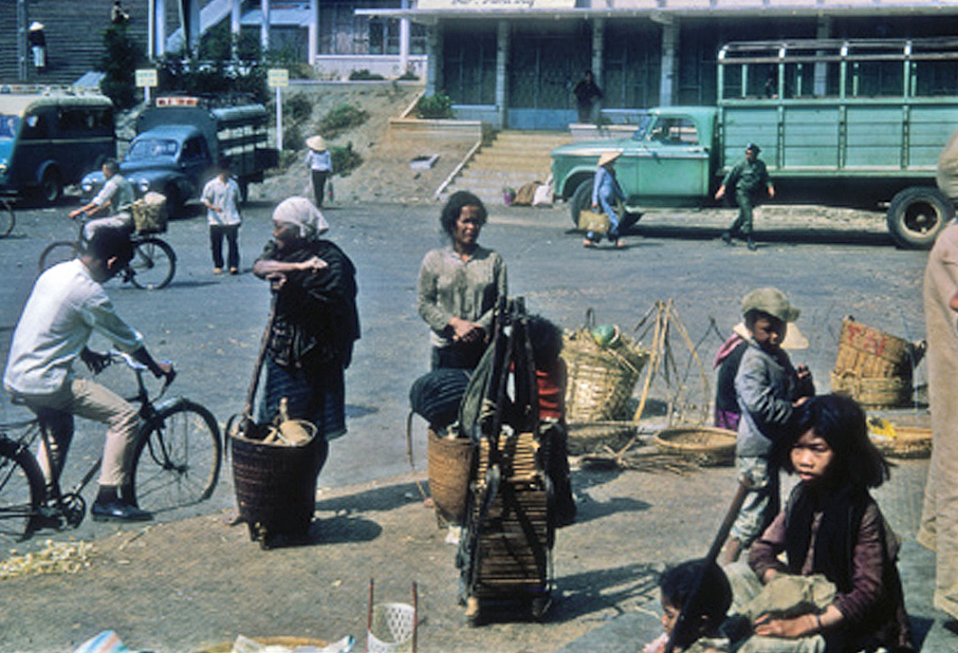
-VIDEO : Đà Lạt năm 1970 :


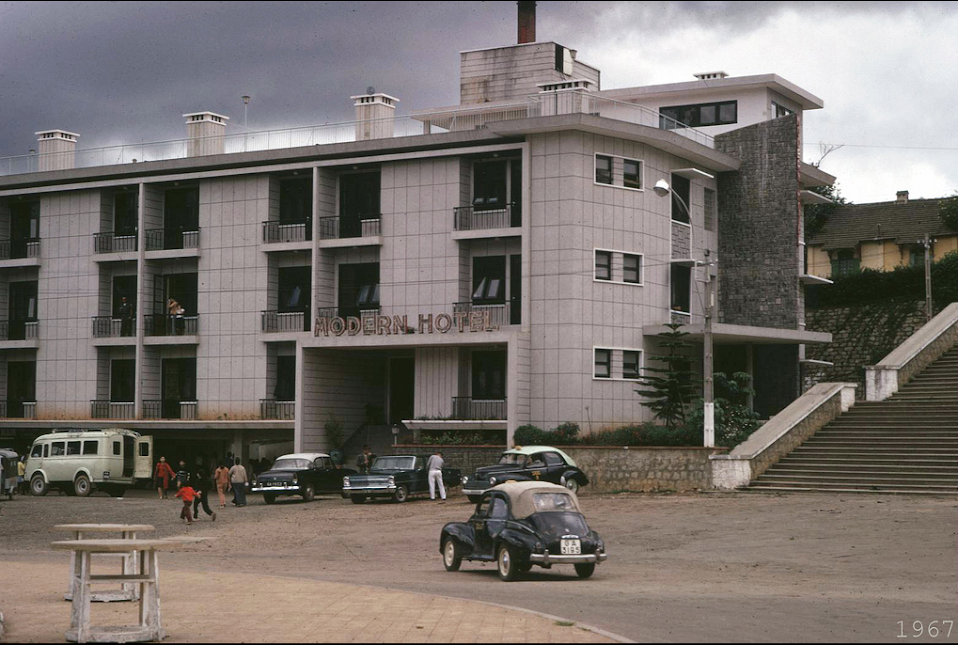
-Dalat 1967_Photo by Phillip M. Kemp.- Modern Hotel (where crew stayed while on special assignment)

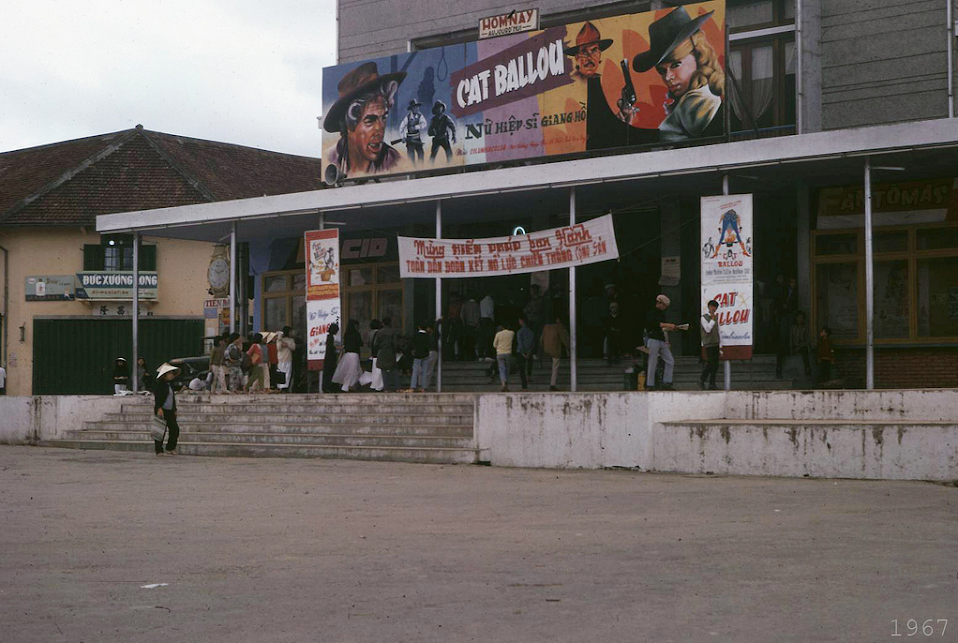
DALAT 1967 - Movie Theater.


DALAT_Jan.08, 1965 - Sinh Viên Sĩ quan Trường Võ Bị Quốc Gia Đà Lạt dạo phố
DALAT, SOUTH VIETNAM - JANUARY 08: South Vietnamese Military Academy students walk on January 8, 1965 in Dalat, South Vietnam. (Photo by The Asahi Shimbun via Getty Images)








Hồ Than Thở ( Người Pháp đặt tên hồ là Lac des Soupirs) 1970.
- Dalat Cathedral
Dalat - l'Eglise St Nicolas
The gingerbread-style Dalat Cathedral was built between 1931 and 1942 for use by French residents and holiday-makers. The cross on the spire is topped by a weathercock, 47m above the ground.
The Dalat Cathedral began to be built in the year 1931 and was completed in 1942. As most of the buildings of the Vietnam of Indochina, the stained glass windows were brought directly from France, 70 stained glass to be exact.
The building measures 65 meters long, 47 meters high and 14 meters wide, which makes this Cathedral the largest church in Dalat.
The main entrance of the Church is oriented towards the Lang Biang mountain and walls of the Cathedral, made of masonry, have a thickness of 40 centimeters.
Every year at Christmas, thousands of worshipers congregate inside and around the cathedral to celebrate.
DALAT - CATHEDRALE - NHA THO CHANH TOA DALAT

Tượng Chúa nhìn vào nhà thờ.
- The Dalat Palace is an historic luxury hotel in Da Lat, Vietnam. It was frequented by the colonial French as a popular get-away.
Originally called the Lang-Bian Palace Hotel, it was completed and opened in 1922, at the height of an economic boom, and was designed to be a site of colonial leisure and power. 'The hotels monumentalism, modernity, luxury and location made it a conspicuous symbol of French domination over the Indochinese central highlands.'It was positioned at the centre of a European business and administrative quarter, dominated the "native quarters" and served as a buffer between them and the European villas. As a luxurious establishment it could act also as a serene base from which to explore highland minority villages or conduct big-game expeditions, and meant to compete with the poshest colonial hotels of Southeast Asia, such as the Oriental Hotel, Bangkok and the Raffles Hotel, Singapore. It initially featured thirty-eight luxury rooms, as well as an orchestra, a cinema, tennis courts, private fruit and vegetable gardens, a dance hall, riding facilities, gymnastic equipment and a French restaurant. Architectutrally the Palace followed metropolitan French resort styles, merging elements of spa towns like Vittel with seaside architectural elements borrowed from towns like Cabourg or Cannes. French novelist w:fr:Morgan Sportès, in his depiction of Indochina during WW2, has described it as reminiscent of the Negresco Hotel, in Nice. When economic circumstances changed, later in the 1920s, most plans for government structures in Dalat were abandoned, leaving the town with a Palace Hotel as its monumental centerpiece.
In 1925 a city health inspection reported that the kitchens and their surroundings exhibited, "a condition of considerable filth"
The Lang-Bian Palace Hotel in the 1920s -it was completed and opened in 1922 before Vichy governor general of Indochina, Jean Decoux, in 1943, got rid of the ornate façade.
In 1943, under the Vichy governor general of Indochina, Admiral Decoux, the façade was altered, and changed to a starker exterior. This was 'almost certainly inspired by architect Paul Vesseyre's two other 'Palaces' in Dalat, Bao Dai's and the governor generals, built in 1934 and 1937 respectively, in a style more of art deco or even Bauhaus than of the fin-de-siècle spa style.' Decoux did not like what he regarded as out-dated ornamentation and was part of a movement at this time to simplify complex lines and to cut out rococo elements. Other examples of Decoux's attitude were the treatment he visited upon the palace of the governor general of Cochinchina in Saigon, removing the two caryatids, and the celebrated Saigon theatre, whose statues and bas-reliefs were destroyed on Decoux's orders.
The Lang-Bian/Dalat Palace became the Dalat Palace after the Second World War.

En vacances en 1933 dans l’élégante station climatique de Dalat, Marie-Thérèse Nguyễn Hữu Thị Lan est entraînée par son oncle, contre son gré, à une réception au Langbian Palace, donnée par le gouverneur Pierre Pasquier où l’ancien résident en Annam, M. Charles, et le maire de Dalat, ont l’intention de les présenter au jeune roi Bao Dai, rentré de France depuis un an. Les deux jeunes gens ont reçu une éducation moderne à l’européenne.

Dalat Palace Hotel - 1966
Dalat Palace is a living testament to a bygone era. Built under the French Governor, it first opened in 1922.The hotel underwent extensive renovation and refurbishment in 1993. It later reopened in 1995.The majestic style and historical architecture has been maintained. The History of the Climate Resort of Dalat gravitates around the named “Hotel Du Lang Bian” or “Lang Bian Palace Hotel”.
Soon after being discovered by Professor Alexandre Yersin in 1893, the decision was taken to create a Climate Resort on the Lang Bian plateau.
The construction of the town started in 1905; a Hotel of First Category or “Palace Hotel” as the French would name them was necessary to attract the high society of Saigon. The architecture, style and concept was done before WWI and started in 1914. This delayed the start of construction which begun in 1916. The Lang Bian Palace opened in 1922, it was then the largest building of the whole area, located ideally facing the man-made lake, opposite the land kept for the future Golf course.
Dalat has many homes built of wood much like the Swiss chalets found in the Alps. It also has many grand villas built by French officials during the early part of the century.
The city literally developed around the hotel. It was first refurbished in 1942, when Dalat was planned to become the Capital City of Indochina, gathering Viet Nam, Cambodia and Laos. The style was the modern Art Deco trend of the late 30’s.
It remained open as a hotel since its opening until now, even throughout wars and uncertain times. The latest remodelling occurred in the early 1990’s, to be restored in its grand Victorian style that you can enjoy today at the Dalat Palace Luxury Hotel & Golf Club.
Larry Lee Hillblom (May 12, 1943 – May 21, 1995) was an American businessman, and a co-founder of DHL Worldwide Express, a shipping company
In Vietnam, he spent $40 million to restore the Dalat Palace Hotel as well as the Dalat Palace Golf Course, in an attempt to recreate colonial times. Other investments included the Novotel Dalat, Novotel Phan Thiet and Ocean Dunes Golf Course and the Riverside Apartments outside Ho Chi Minh City. The investment was done via an overseas holding company to avoid an American embargo against Vietnam. The Dalat Palace Hotel featured French restaurants and "Larry's Bar". The hotel opened in 1995 under Hillblom and his Vietnamese partners' ownership with management personnel provided by Accor.
Hillblom is described in his biography by James Scurlock, King Larry: The Life and Ruins of a Billionaire Genius, as having raped underage girls after moving to Saipan
Dalat, c’est la petite France, avec ses villas coloniales au milieu des pins…L’endroit a été reconnu par Yersin en 1893, puis proposé à Paul Doumer, alors Gouverneur de l’Indochine, pour y fonder une station d’altitude, permettant aux Saïgonnais de bénéficier de la douceur du climat. Située à 300 km de Saigon et à 75km de la mer, Dalat est à 1500 mètres d’altitude.
Elle mettra du temps à prendre son essor, car son isolement dans une vallée fort boisée et difficile d’accès nécessite des infrastructures onéreuses. De plus, les fonctionnaires préféraient bénéficier du congé périodique en France, dont le coût du transport par bateau était payé par l’administration, plutôt que de rester en Indochine.
C’est finalement la 1ère guerre mondiale – et l’isolement de l’Indochine - qui va accélérer le développement de cette station. Les villas se multiplient apres 1917, le Golf vers 1920, le Grand Hôtel en 1922, et la cathédrale dans les années 30. Une ligne de chemin de fer relie Dalat au littoral dès 1933.
C’est surtout la présence de nombreux gibiers (éléphants, tigres, gaur …) qui va faire connaître la station dans le monde entier. Les chutes d’eau sont aussi nombreuses que spectaculaires.
Par la suite, la ville a été protégée de la guerre par un accord tacite entre les belligérants.
Aujourd’hui, la ville compte plus de 150.000 habitants et les édifices construits du temps des français est encore nombreux. On recense encore plusieurs centaines de villas de l’époque coloniales et de jolis bâtiments publics (gare, église, université, écoles, couvents, le Palais Bao Dai..).
La ville vietnamienne s’est fortement développée, et a envahi la plupart des parcelles disponibles, mais Dalat garde son atmosphère particulière. Les Vietnamiens (voyage de noce notamment) sont nombreux a s’y rendre. Quant aux occidentaux, ils sont souvent déçus, en raison justement du manque d’exotisme de la cite, de la pluie et de la fraicheur du climat.
Les richesses de la ville aujourd’hui, en dehors du tourisme, ce sont les cultures maraîchères et horticoles. Les artichauts (pour les tisanes), les fraises et les roses de Dalat sont célèbres dans tout le sud Vietnam.


Le « Palace Hôtel », superbe bâtiment construit en 1922, est gèré aujourd'hui par le groupe Accor. Il dispose d’une large vue donnant sur le lac et derrière, le golf. C’est l’un des rares endroits ou la vue reste dégagée…

La gare de Dalat, qui ressemble fortement a celle de Deauville… Seuls quelques kilomètres de rails sont encore utilisés pour les touristes.

Le Lycée Yersin, édifice en brique et pierres aux lignes arrondies…
Nombreuses sont les congrégations religieuses présentes à Dalat. Le « Couvent des Oiseaux », qui a vu passer toute l’élite vietnamienne avant 1975, est le plus célèbre. Trois religieuses veillent aujourd’hui sur ce trésor du temps passé.
Ci dessous, le Domaine de Marie, couvent tenu par les sœurs de St Vincent de Paul.
Madame Jean Decoux, épouse du Gouverneur Général de l’Indochine (de 1940 à 1945), s’était tuée accidentellement en voiture à Dalat, le 6 janvier 1944, alors qu’elle se
rendait à la résidence d’été de l’Empereur Bao Dai.
Madam Decoux, née Suzanne Humbert, est inhumée au Couvent du Domaine de
Marie près du mur de la chapelle car elle avait été déclarée bienfaitrice de
ce couvent par les Filles de la Charité de Saint Vincent de Paul.
Ce couvent dispose d’une très belle boutique pour les touristes car les
orphelines prises en charge totalement par les Soeurs, réalisent des
broderies superbes. Cette boutique les aide en partie à supporter les frais
d’internat pour les jeunes-filles scolarisées. Une trentaine de garçons sont
aussi pris en charge par les Soeurs car ils sont handicapés (sourds) et

-VIEW :VIETNAM DALAT :SUR LES TRACES DU PASSE du 18 au 22-12-2016.
La route nous mène à Dalat sur les Hauts Plateaux. Dalat est nichée à plus de 1500m d’altitude dans un cirque de collines boisées de sapins. Durant l’ère indochinoise, le Dr Yersin (Inventeur du sérum conte la peste) découvre ce coin alors méconnu des européens. Le climat frais du site l’amène à proposer au Gouverneur Général de l’Indochine Mr Paul Doumer de créer une ville thermale sur ces lieux bien loin de l’implacable chaleur de la Cochonchine.
Les plans de la ville sont établis, un immense lac artificiel est creusé par un certain Mr Elie Cunhac (Oui vous l’avez bien compris l’un de mes ancêtres, auquel nous rendons hommage !), de superbes villas et chalets sont édifiés, des écoles, une Cathédrale, un couvent, et même un Institut Pasteur. La ville devient vite l’une des stations de villégiature les plus chics d’Asie du Est. Des hôtels luxueux voient le jour, l’Empereur du Vietnam Bao Dai y installe sa résidence non loin du Pavillon de Chasse de Théodore Roosevelt, et c’est ainsi que dans les année 1920 1930 Dalat est appelée le « Petit Paris ».
Relativement épargnée par les guerres et bien que la cité se soit étendue, le Dalat à l’architecture indochinoise est resté quasi intacte et en fait un lieu si attachant..

Dalat - Le Lac St Benoit - La Rotonde
DALAT - Cercle nautique - Câu lạc bộ thể thao dưới nước
Nhà Thuỷ tạ nguyên là Câu lạc bộ thể thao dưới nước, được người Pháp gọi tên vui là Grenouillère (tổ ếch) vì nơi đây có những bục dành cho người bơi lội phóng từ bục xuống hồ như những chú ếch...
-VIDEO: *** ĐÀ LẠT *** 1945 *** 🌹 by René Ruffier

Xuan Huong lake is the most beautiful lake in Da Lat. It is approximately 5 km2. In 1919 a dam was formed on a branch of Camly river creating a small lake. In 1923, another dam was built further down stream to create yet another lake. During a severe storm in 1932, both dams were destroyed. Between 1934-35, a larger dam was built of boulders (site of Ong Dao bridge today) below the sites of the two previous dam creating one large lake named Ho Lon or Large lake. Ho Lon was later renamed after Ho Xuan Huong, a famous vietnamese poet in the 17th-century.
Da Lat is also famous for its many waterfalls and lakes, one of which is Ho Xuan Huong (Xuan Huong lake). This man made lake was a site where many indigenous people of Langbian high land made their homes. In 1984, the lake was emptied for renovation purposes. At the bottom of the lake, scientists found many relics belonging to the hill tribe that once lived in this area. Xuan Huong lake is shaped like the crescent moon. Visitors to Da Lat and the town's people use the lake as a place to meet and talk. The lake is also where many honeymooners come to visit.
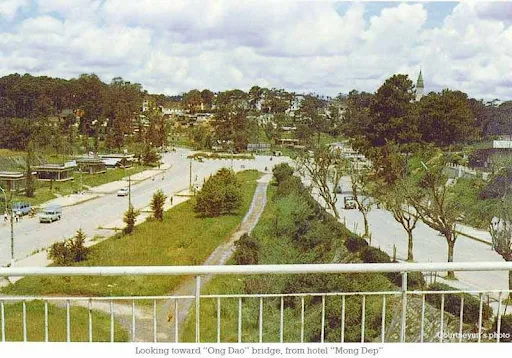

- DALAT Xưa
Hồ THAN THỞ

Thác CAM LY
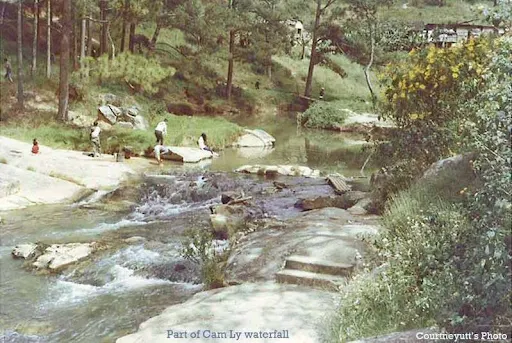
Thác PRENN
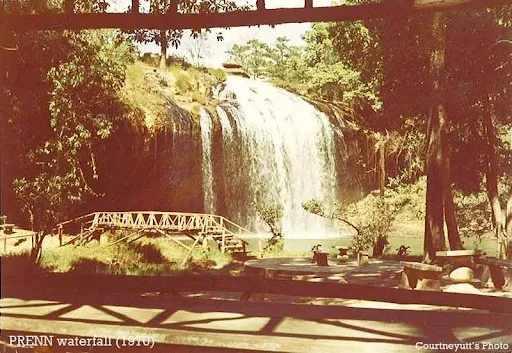
-PHOTO :Dalat năm xưa_135 photos
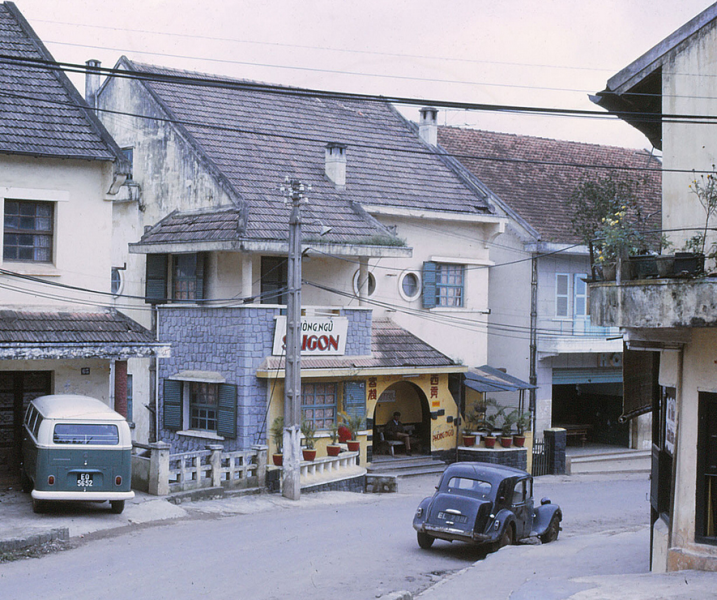
Dalat street scene 1970

DALAT 1970 - Linh Sơn Pagoda.
-VIDEO :Linh Son Pagoda in Dalat - Chùa Linh Sơn Đà Lạt

Entrance to Buddhist temple, Dalat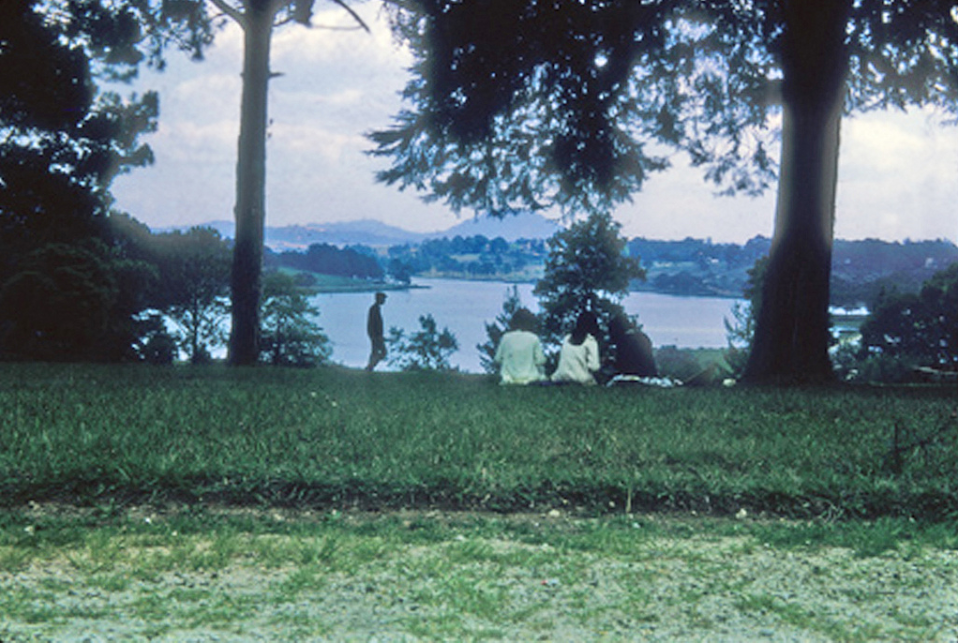

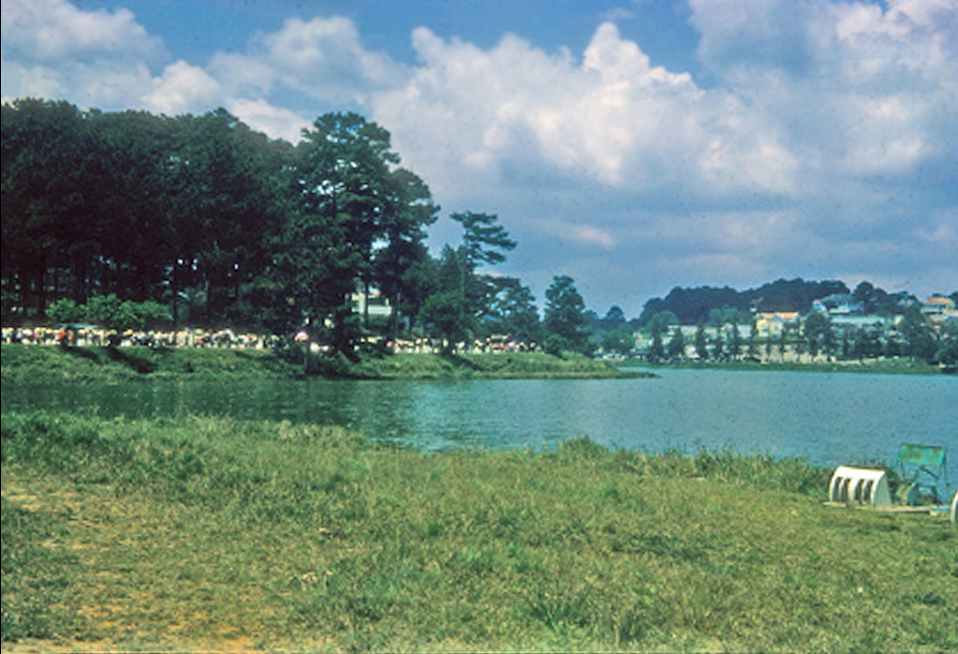

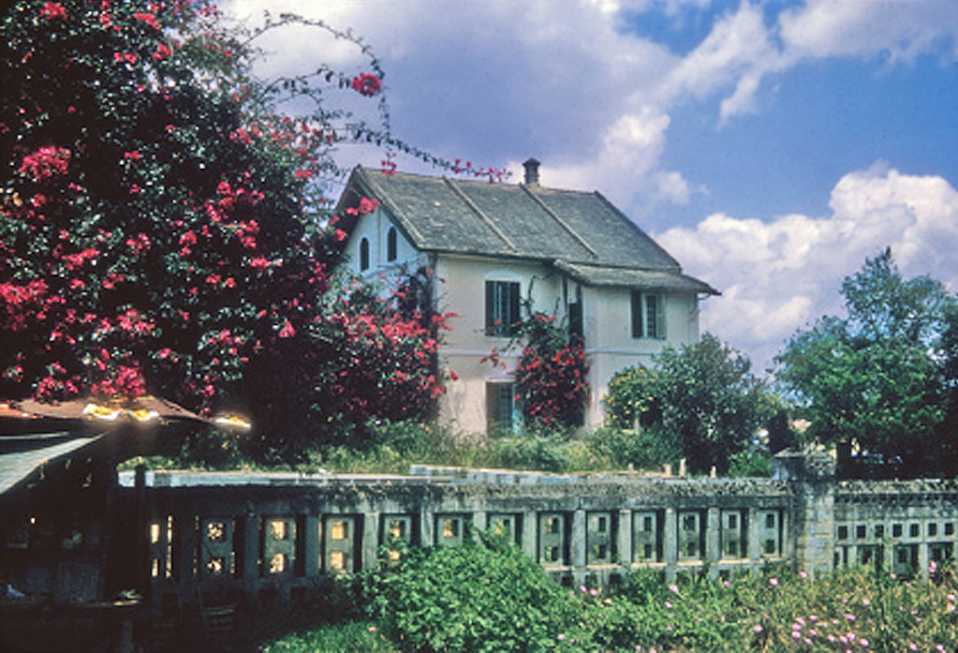

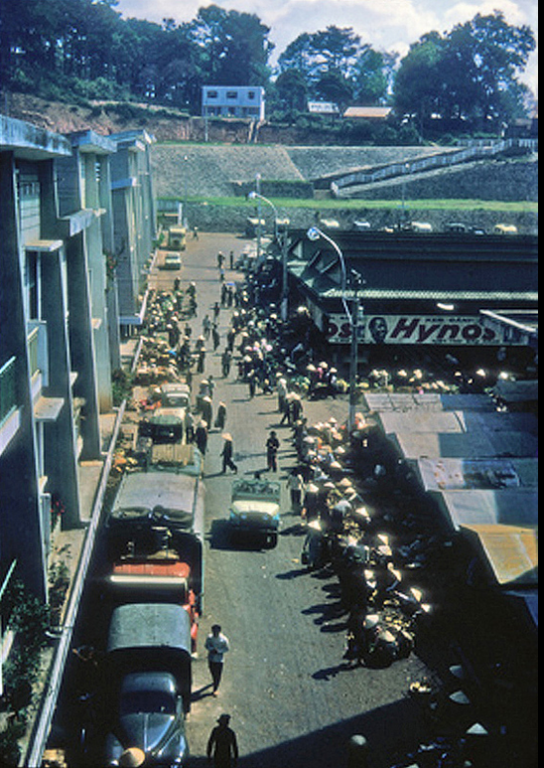
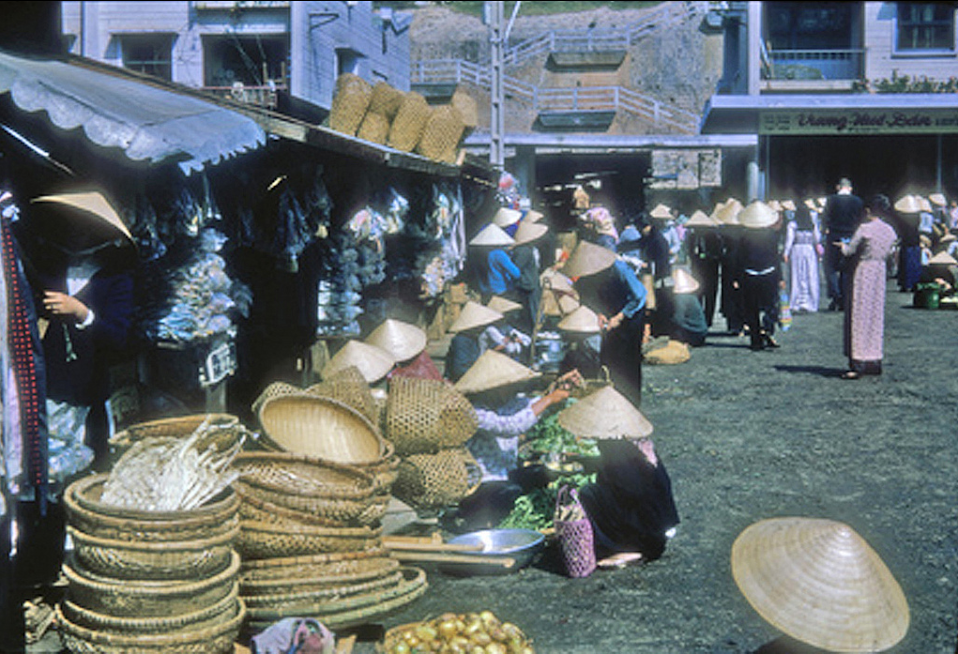

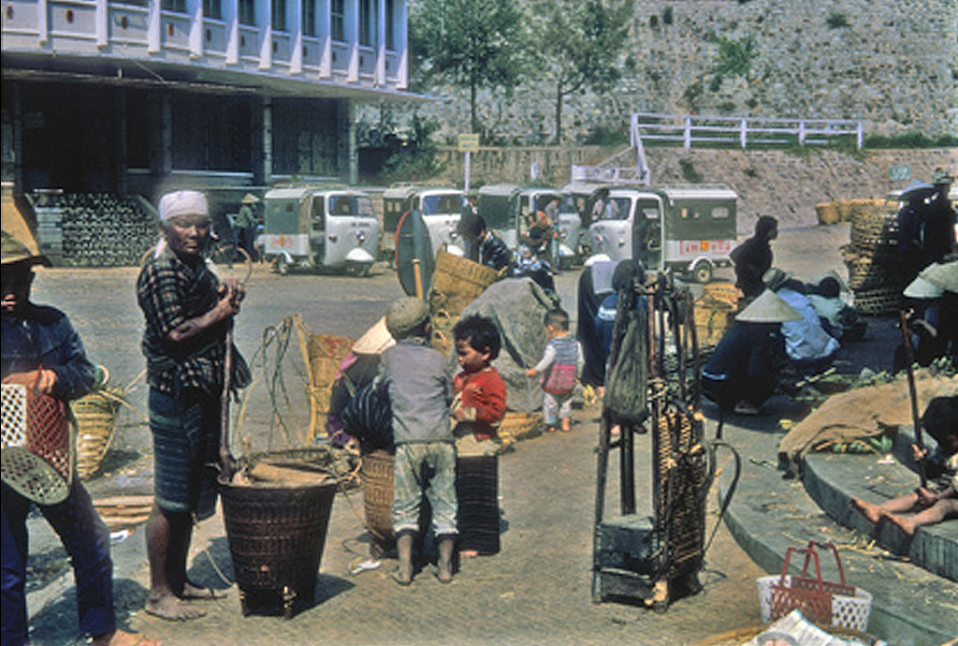
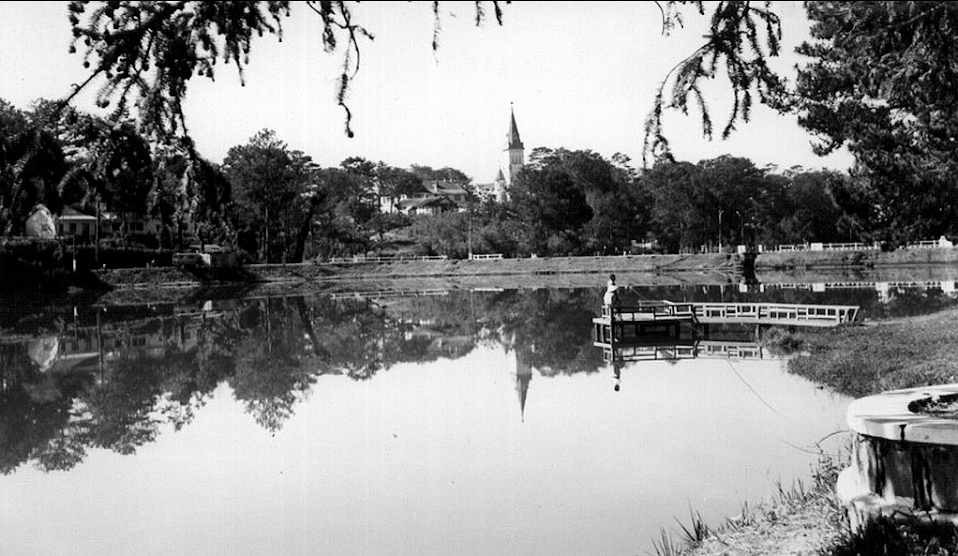


PRENN Waterfall_Dalat_Before 1975.


Đà Lạt, May 1967 - Cam Ly Waterfall - Photo by Will Miller

Đà Lạt, Dec1970 - Cam Ly Waterfall
-Dalat Cam Ly - At The Airfield :

Cam Ly Airport & Đà Lạt 1967/68 - Photo by Aviatorr727
-Chiều Vàng (Nguyễn Văn Khánh) Khánh Ly (1963):

Liên Khương Terminal - Đà Lạt 1960 - Photo by Ross Mc' Kimmey

Liên Khương Airport - Photo by Peter A. Bird 1971










-MOVIE : Chiếc bóng bên đường (1973)_Diễn viên : Kim Cương, Kiều Chinh, Thành Được,bà Bảy Nam...và nhạc sĩ Vũ Thành An.

Prenn Waterfall - Đà Lạt 1970 - Photo by Courtneyutt


Thác Prenn - 1963


Pongour Falls, the largest waterfall in Dalat - 1963


Thác Pongour còn gọi là thác Bảy tầng nằm tại huyện Đức Trọng, tỉnh Lâm Đồng, cách Đà Lạt 50 km về hướng Nam

Gougah Falls
Thác Gougah còn có tên gọi là thác Ổ Gà, nằm sát quốc lộ 20, thuộc xã Phú Hội, huyện Đức Trọng, cách Đà Lạt khoảng 37km



Dalat - Lien Khang Chute 1925-30
Thác Liên Khương có tên cũ là Liên Khàng, nằm ngay ngã ba Liên Khương, thuộc huyện Đức Trọng, cách thành phố Đà Lạt gần 27 km, bên cạnh quốc lộ 20

Đập Đa Nhim - Dam (Không Ảnh 1968 - Photo by Bill Robie)

Đập Ankroet dam (Suoi Vang) ,Dalat circa 1970.



-Nhà thờ Domaine de Marie _Dalat
Nhà thờ và tu viện Domaine de Marie_Nhà thờ được xây dựng từ năm 1930 đến 1943 theo phong cách châu âu của thế kỷ 17, Nhà thờ kết hợp giữa kiến trúc nhà rông tây nguyên và kiến trúc phương tây . Nơi đây là một cụm kiến trúc bao gồm nhà nguyện và hai dãy nhà của tu viện nữ tử bác ái Thánh Vinh Sơn, nằm tại đường Ngô Quyền phường 6, Thành phố Dalat.


Nội thất bên trong nhà thờ
Ci dessous, le Domaine de Marie, couvent tenu par les sœurs de St Vincent de Paul.
Madame Jean Decoux, épouse du Gouverneur Général de l'Indochine (de 1940 à 1945), s'était tuée accidentellement en voiture à Dalat, le 6 janvier 1944, alors qu'elle se rendait à la résidence d'été de l'Empereur Bao Dai.
Madam Decoux, née Suzanne Humbert, est inhumée au Couvent du Domaine de
Marie près du mur de la chapelle car elle avait été déclarée bienfaitrice de
ce couvent par les Filles de la Charité de Saint Vincent de Paul.
Ce couvent dispose d'une très belle boutique pour les touristes car les
orphelines prises en charge totalement par les Soeurs, réalisent des
broderies superbes. Cette boutique les aide en partie à supporter les frais
d'internat pour les jeunes-filles scolarisées. Une trentaine de garçons sont
aussi pris en charge par les Soeurs car ils sont handicapés (sourds) et
ainsi scolarisés.
 Nhà thờ Domaine de Marie còn là một điểm tham quan không thể thiếu khi đến Dalat
Nhà thờ Domaine de Marie còn là một điểm tham quan không thể thiếu khi đến Dalat-VIDEO : ** 🌲 ** ĐÀ LẠT 🌹 trước 1975 ** 🌲 ** Những thước phim xưa 💐
Le Couvent des Oiseaux
Difficile de ne pas consacrer une page de ce site au Couvent des Oiseaux, qui fut le symbole le plus prestigieux de la geste française en Indochine. Cette école, c'est tout à la fois l'apprentissage des bonnes manières, l'excellence en terme d'éducation - à la fois sur la manière d'enseigner et sur le contenu - et un formidable relais de la langue et de la culture française. C'est aussi une Indochine idéalisée, avec une cohabitation réussie entre plusieurs cultures. Un oasis de sérénité au milieu d'un pays en plein bouleversement.
Tout a commencé avec Marie Thérese Huu Hao, la future épouse de Bao Dai, l'impératrice Nam Phuong. Avant d'épouser Bao Dai, elle fit ses études au sein de la congrégation Notre Dame, rue de Ponthieu à Paris, communément appelé le "Couvent des oiseaux".
De retour en Indochine, et gardant un excellent souvenir du pensionnat, elle décida, un fois impératrice, de soutenir la création d'un établissement similaire à Dalat, en offrant des terrains. Cet établissement a vu le jour en 1935. On l'appela le Couvent de Notre Dame du Lang Bian, mais le nom commun reste le "Couvent des Oiseaux". Ce fut alors le point de convergence de toute la bourgeoisie du sud Vietnam. Situé dans une station balnéaire - Dalat - aussi chic, à l'époque, que le 16eme arrondissement de Paris. L'établissement, réservé aux jeunes filles, vit affluer, coté français, des filles de fonctionnaires et de colons aisés. Les grandes familles vietnamiennes, laotiennes ou cambodgiennes y inscrivirent également leurs enfants, soucieuses de leurs donner le meilleur de l'éducation occidentale. L'élite féminine vietnamienne a été formée ici avant de fuir, hélas, aux quatre coins de la planète.
-VIEW :Le Couvent des Oiseaux
1-Lycée Chasseloup Laubat Saigon
2-Lycée Marie Curie Saigon
3-Lycée Yersin Đà Lạt
4-Và Lycée Couvent des Oiseaux Đà Lạt

Empress Nam Phương _Từng là Couventine
Empress Nam Phương (14 December 1914 – 16 December 1963), born Marie-Thérèse Nguyễn Hữu Thị Lan, later Imperial Princess Nam Phương, was the first and primary wife of Bảo Đại, the last emperor of Vietnam, from 1934 until her death. She also was the first and only empress consort (hoàng hậu) of the Nguyễn Dynasty
-VIEW : Rể Gò Công : Bảo đại.
-VIEW :HOÀNG TRIỀU CƯƠNG THỔ – ĐI NGƯỢC GIÒNG THỜI GIAN

Nữ sinh Trường Trung học Bùi Thị Xuân - Đà Lạt _những năm 60 thế kỷ XX

Trường Nữ Trung Học Bùi Thị Xuân, Đà Lạt, 1971.




Cổng Trừơng Trần Hưng Đạo (1967).
-VIEW :TRƯỜNG XƯA TRẦN HƯNG ĐẠO_DALAT.

-Nghi Lễ Trần Hưng Đạo(1967)_ Bà luật sư Nguyễn Thị Hậu – Thị trưởng Đà Lạt (1965 – 1966), thắp hương trứơc Bàn Thờ tại Trừơng Trung Học Trần Hưng Đạo Đà Lạt.


-VIEW :Photos of Trường Trần Hưng Đạo Đà Lạt
“Vòng tay học trò là câu chuyện có thật tại trường Trần Hưng Đạo Đà Lạt giữa cô giáo đệ nhất cấp Nguyễn Thị Hoàng và cậu học sinh đệ nhị cấp Mai Tiến Thành. vốn là bạn học rất thân với T. từ năm Đệ Ngũ trên Ban Mê Thuột nên biết rõ chuyện tình của T. Tuy nhiên, những gì xảy ra ngoài đời thực có phần nào khác với Vòng tay học trò, đó là kỹ thuật ‘thêm mắm thêm muối’ của nhà văn Nguyễn Thị Hoàng. Nói khác đi, phần hư cấu trong tiểu thuyết được giữ ở mức vừa phải, có thể chấp nhận được”. Nữ văn sĩ thì lại xác định một cách nửa vời về Vòng tay học trò: “

-Nghi Lễ Trần Hưng Đạo(1967)_ Bà luật sư Nguyễn Thị Hậu – Thị trưởng Đà Lạt (1965 – 1966), thắp hương trứơc Bàn Thờ tại Trừơng Trung Học Trần Hưng Đạo Đà Lạt.


-VIEW :Photos of Trường Trần Hưng Đạo Đà Lạt
“Vòng tay học trò là câu chuyện có thật tại trường Trần Hưng Đạo Đà Lạt giữa cô giáo đệ nhất cấp Nguyễn Thị Hoàng và cậu học sinh đệ nhị cấp Mai Tiến Thành. vốn là bạn học rất thân với T. từ năm Đệ Ngũ trên Ban Mê Thuột nên biết rõ chuyện tình của T. Tuy nhiên, những gì xảy ra ngoài đời thực có phần nào khác với Vòng tay học trò, đó là kỹ thuật ‘thêm mắm thêm muối’ của nhà văn Nguyễn Thị Hoàng. Nói khác đi, phần hư cấu trong tiểu thuyết được giữ ở mức vừa phải, có thể chấp nhận được”. Nữ văn sĩ thì lại xác định một cách nửa vời về Vòng tay học trò: “
-VIDEO :AI LÊN XỨ HOA ĐÀO - ÁNH TUYẾT
-VIDEO : HÌNH ẢNH Dalat ngày cũ_Slideshow
-VIDEO : HÌNH ẢNH Đà Lạt - Tuyên Đức_Slideshow
-Vietnam Documentary in Video _Miền Nam Việt Nam trứơc 1975 :
- VIEW : ĐÀ LẠT NGÀY THÁNG CỦ_À la recherche du temps perdu – Remembrance of Things Past
-VIEW :TRACING THE FORGOTTEN PATH TO THE LOST SHANGRI-LA._(A BRIEF HISTORY OF DALAT RAILWAY.)
-VIEW :Tùy bút Đà Lạt và Lê Uyên Phương

-VIEW: Đà Lạt Ngày Tháng Cũ
-Vietnam - Mon Pays Natal - Quê Hương Tôi - Đà Lạt - Nha Trang_playlist by Vinh-Thien Quach :


.jpg)













Tài liệu quá hay,đầy giá trị theo thời gian,hình ảnh đẹp, rất rõ nét, công phu. Thành-thật Cảm-Ơn Bạn rất nhiều...
ReplyDeleteLoovely blog you have
ReplyDeleteI love learning about the history and architecture of Đà Lạt.
ReplyDelete